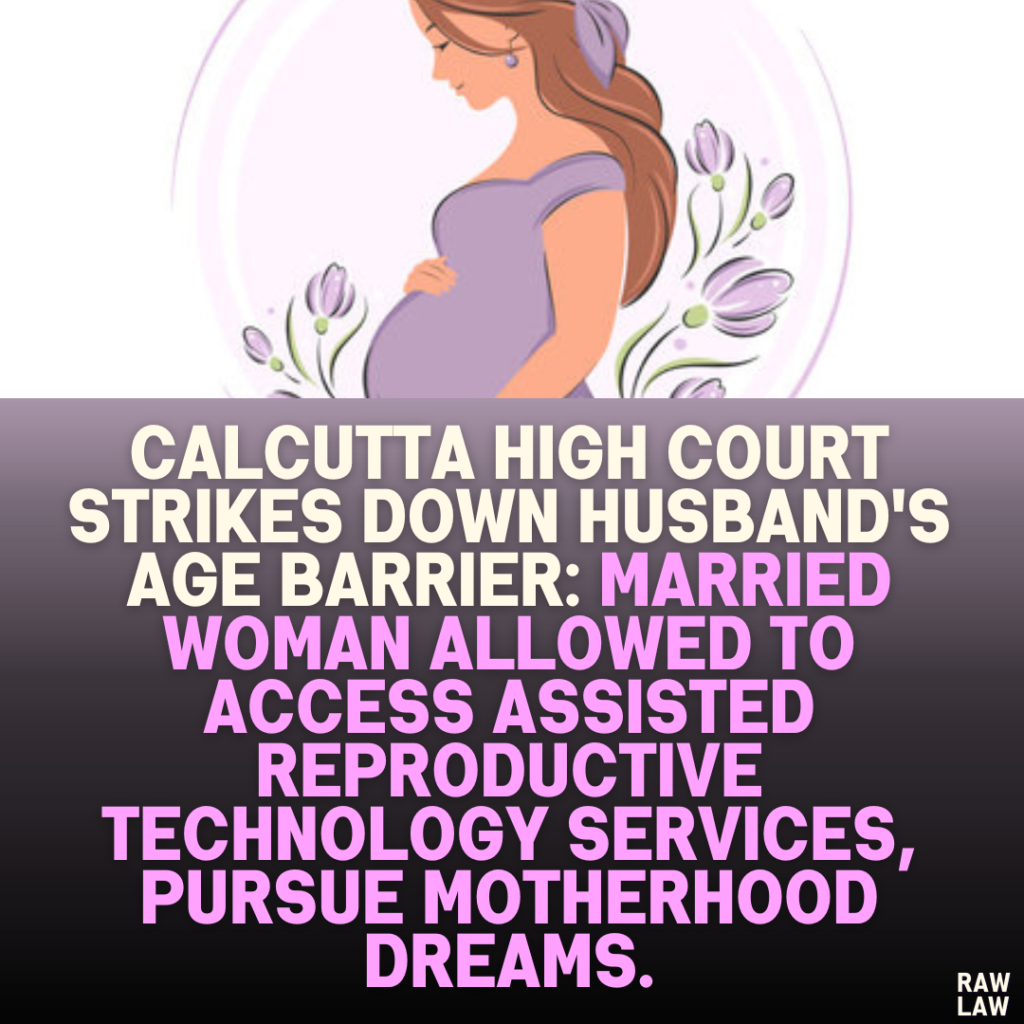Court’s Decision
The Calcutta High Court ruled that a married woman can independently access Assisted Reproductive Technology Services (ARTS) even if her husband does not meet the prescribed age criteria under Section 21(g) of the Assisted Reproductive Technology (Regulation) Act, 2021. The Court directed the respondent clinic to provide ARTS to the petitioners, emphasizing that the law should not be applied rigidly to cause injustice.
Facts
The petitioners, a married couple unable to conceive despite 30 years of marriage, approached the court for relief. The wife was within the legal age limit to avail ARTS, but the husband, at 58 years old, exceeded the maximum allowable age of 55 years under the Act. The clinic denied services without a court order, citing the age restriction.
The couple proposed to use donated sperm and ova from third parties, with the wife acting as the gestational carrier. Medical reports confirmed that the wife was physically fit to undergo the procedure.
Issues
- Does Section 21(g) of the Act prevent a woman from accessing ARTS independently when her husband exceeds the age limit?
- Should the denial of services to a married woman solely due to her husband’s ineligibility be considered just and fair under the law?
Petitioner’s Arguments
- The wife met all legal and medical criteria for accessing ARTS and sought to act as a gestational carrier using donor gametes.
- Denial of ARTS due to the husband’s age would unjustly penalize the wife, who is otherwise eligible and fit for the procedure.
- The couple emphasized that the husband’s role was limited to providing financial and moral support, with no biological involvement in the process.
Respondent’s Arguments
- The State cited Section 21(g), which restricts ARTS for men above 55 years of age, highlighting concerns about parenting responsibilities, health risks, and ensuring the child’s well-being.
- The Ministry of Health supported these restrictions, emphasizing the importance of parental stability and the risks of advanced paternal age.
Analysis of the Law
The Assisted Reproductive Technology (Regulation) Act, 2021, defines “patients” broadly, allowing both individuals and couples to access ARTS. Section 21(g) imposes age limits to address ethical and practical concerns, including ensuring the well-being of children born through ART and preventing misuse of technology.
However, the law does not mandate that both partners in a couple must meet the age criteria to access ARTS. It permits an individual within the prescribed limits to independently avail the service.
Precedent Analysis
The Court relied on earlier judgments:
- Sanchita Ghosh & Anr. vs. Union of India & Ors., which allowed one partner to avail ARTS if the other was ineligible due to age.
- Sudarshan Mandal & Anr. vs. State of West Bengal & Ors., which upheld a similar interpretation of the law.
Both cases emphasized a pragmatic approach to the application of Section 21(g), ensuring justice without contravening legislative intent.
Court’s Reasoning
- The Act does not prohibit a woman from independently accessing ARTS even if her husband exceeds the age limit.
- The wife satisfied both medical and legal requirements to proceed with the procedure.
- The husband’s ineligibility should not bar the wife from fulfilling her desire to conceive through ART. His role was limited to providing moral and financial support, which he was willing and capable of doing.
- Denying the service based solely on the husband’s age would cause undue hardship and injustice to the wife.
The Court clarified that the legislative purpose of the age limit is to ensure ethical practices and parental responsibility, not to create insurmountable barriers for eligible individuals.
Conclusion
The Court directed the clinic to provide ARTS to the petitioners, emphasizing that the law must be interpreted to uphold justice. It acknowledged the couple’s long-standing desire for a child and recognized the wife’s right to access ART services as an independent, eligible individual.
Implications
This decision underscores the importance of balancing statutory provisions with individual rights. By allowing the wife to access ARTS independently, the Court affirmed that legal restrictions should not unjustly prevent eligible individuals from seeking medical assistance. The ruling also sets a significant precedent for interpreting age limits under the ART Act in a manner that promotes fairness and justice.
